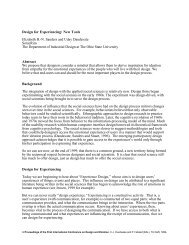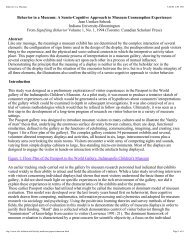: Interface as Content The Construction of Experience - ec(h)o
: Interface as Content The Construction of Experience - ec(h)o
: Interface as Content The Construction of Experience - ec(h)o
You also want an ePaper? Increase the reach of your titles
YUMPU automatically turns print PDFs into web optimized ePapers that Google loves.
David Rokeby : Transforming Mirrors3/11/03 4:21 PM<strong>of</strong>ten involuntarily fall into sync with one <strong>of</strong> those rhythms, then exclaim that the system is so“intelligent” that it synchronized to their movement!This illustrates an interesting side eff<strong>ec</strong>t <strong>of</strong> real-time interactive feedback loops. An actionprovokes a response which immediately provokes a shift in action which likewise immediatelychanges the system’s response, ad infinitum. <strong>The</strong> issue <strong>of</strong> who is controlling whom b<strong>ec</strong>omesblurred. <strong>The</strong> intelligence <strong>of</strong> the human interactors spreads around the whole loop, <strong>of</strong>ten comingback in ways they don’t r<strong>ec</strong>ognize, causing them to attribute intelligence to the system.CONSCIOUSNESS LAGS BEHIND THE BODYAnother re<strong>as</strong>on for the confusion between what we <strong>as</strong> interactors do and what the system does,is that our consciousness seems to trail our actions by up to one tenth <strong>of</strong> a s<strong>ec</strong>ond. It takes that longfor us to be fully aware <strong>of</strong> what we’re doing. I once programmed “Very Nervous System” to respondvery clearly <strong>as</strong> soon <strong>as</strong> it saw the slightest movement. In every instance, the system respondedbefore I realized that I’d started moving. In fact, the system seemed to respond at the moment that Id<strong>ec</strong>ided I would move. This delay in consciousness makes it possible for systems with highsampling rates and response speeds to slip under the user’s consciousness. At this point, thesystem and its responses are experienced in the same way that we experience our own body. <strong>The</strong>interactive system b<strong>ec</strong>omes integrated into our proprioceptive system?the same internal sensingsystem that defines our sense <strong>of</strong> being in our body, and establishes the relative position <strong>of</strong> our armsand legs to our “point <strong>of</strong> consciousness.”This phenomenon, like all the others I describe in this text, cuts both ways. Part <strong>of</strong> the desire thatdrove me to produce “Very Nervous System” w<strong>as</strong> a desire to slip out <strong>of</strong> my own self-consciousnessinto dir<strong>ec</strong>t, open experience <strong>of</strong> the world. In the right circumstances, the feedback loop <strong>of</strong> “VeryNervous System” eff<strong>ec</strong>tively neutralizes consciousness, and can occ<strong>as</strong>ionally lead to states thatcould best be described <strong>as</strong> shamanistic. It can be intoxicating and addictive. I made a realbreakthrough in the responsive quality <strong>of</strong> the system in 1987. I’d written a program where powerfuldrum sounds were produced by very aggressive movements. <strong>The</strong> result w<strong>as</strong> extremely satisfying.After a week <strong>of</strong> developing and experiencing this new version, I found that I’d seriously damagedmy back. I’d been throwing my body in the air with abandon, cr<strong>as</strong>hing myself against the virtual insearch <strong>of</strong> those most satisfying sounds. This w<strong>as</strong> a cl<strong>as</strong>sic c<strong>as</strong>e <strong>of</strong> positive feedback.Most natural and stable feedback systems are negative feedback systems, intended to keep <strong>as</strong>ystem in balance. If things get into any extreme state, the feedback m<strong>ec</strong>hanisms work against thatstate to restore balance and maintain the sustainability <strong>of</strong> the situation. This particular tuning <strong>of</strong> the“Very Nervous System” worked in reverse, egging me on to greater feats <strong>of</strong> physical movementuntil I wore myself out.Pushing ourselves out <strong>of</strong> equilibrium is a way <strong>of</strong> opening us to change, but it can also lead toself-destruction or external manipulation. <strong>The</strong> m<strong>ec</strong>hanism that governs the evolution <strong>of</strong> life involvesenormous test periods during which impossible or unsustainable life-forms are weeded out.Humans have evolved over a very long time to be well adapted to the stresses <strong>of</strong> everyday physicalreality, and our sp<strong>ec</strong>ies h<strong>as</strong> evolved ways <strong>of</strong> balancing new pressures. But we now invent newpressures and stresses at an extraordinary rate. While t<strong>ec</strong>hnologies can be developed tocounterbalance some <strong>of</strong> these stresses, the stability <strong>of</strong> this balance is not guaranteed. I’m notadvocating a return to Darwinian rule, just pointing out the seriousness <strong>of</strong> the t<strong>as</strong>k <strong>of</strong> “engineering”this balance.http://www.interlog.com/~drokeby/experience.htmlPage 12 <strong>of</strong> 15





